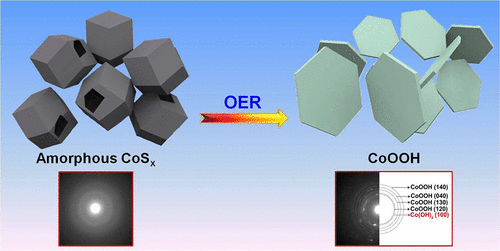Our official English website, www.x-mol.net, welcomes your
feedback! (Note: you will need to create a separate account there.)
Direct Observation of Structural Evolution of Metal Chalcogenide in Electrocatalytic Water Oxidation
ACS Nano ( IF 15.8 ) Pub Date : 2018-12-03 00:00:00 , DOI: 10.1021/acsnano.8b06312 Ke Fan 1 , Haiyuan Zou 1 , Yue Lu 2 , Hong Chen 3 , Fusheng Li 4 , Jinxuan Liu 4 , Licheng Sun 4, 5 , Lianpeng Tong 6 , Michael F. Toney 3 , Manling Sui 2 , Jiaguo Yu 1
ACS Nano ( IF 15.8 ) Pub Date : 2018-12-03 00:00:00 , DOI: 10.1021/acsnano.8b06312 Ke Fan 1 , Haiyuan Zou 1 , Yue Lu 2 , Hong Chen 3 , Fusheng Li 4 , Jinxuan Liu 4 , Licheng Sun 4, 5 , Lianpeng Tong 6 , Michael F. Toney 3 , Manling Sui 2 , Jiaguo Yu 1
Affiliation

|
As one of the most remarkable oxygen evolution reaction (OER) electrocatalysts, metal chalcogenides have been intensively reported during the past few decades because of their high OER activities. It has been reported that electron-chemical conversion of metal chalcogenides into oxides/hydroxides would take place after the OER. However, the transition mechanism of such unstable structures, as well as the real active sites and catalytic activity during the OER for these electrocatalysts, has not been understood yet; therefore a direct observation for the electrocatalytic water oxidation process, especially at nano or even angstrom scale, is urgently needed. In this research, by employing advanced Cs-corrected transmission electron microscopy (TEM), a step by step oxidational evolution of amorphous electrocatalyst CoSx into crystallized CoOOH in the OER has been in situ captured: irreversible conversion of CoSx to crystallized CoOOH is initiated on the surface of the electrocatalysts with a morphology change via Co(OH)2 intermediate during the OER measurement, where CoOOH is confirmed as the real active species. Besides, this transition process has also been confirmed by multiple applications of X-ray photoelectron spectroscopy (XPS), in situ Fourier-transform infrared spectroscopy (FTIR), and other ex situ technologies. Moreover, on the basis of this discovery, a high-efficiency electrocatalyst of a nitrogen-doped graphene foam (NGF) coated by CoSx has been explored through a thorough structure transformation of CoOOH. We believe this in situ and in-depth observation of structural evolution in the OER measurement can provide insights into the fundamental understanding of the mechanism for the OER catalysts, thus enabling the more rational design of low-cost and high-efficient electrocatalysts for water splitting.
中文翻译:

直接观察金属硫属元素化物在电催化水氧化中的结构演变
作为最杰出的析氧反应(OER)电催化剂之一,在过去的几十年中,金属硫属元素化物因其较高的OER活性而得到了广泛报道。据报道,金属硫属元素化物的电子化学转化将发生在OER之后。然而,尚未了解这种不稳定结构的转变机理以及这些电催化剂在OER期间的实际活性位点和催化活性。因此,迫切需要对电催化水氧化过程进行直接观察,尤其是在纳米或什至埃级的情况下。在这项研究中,通过使用先进的Cs校正的透射电子显微镜(TEM),无定形电催化剂CoS x的逐步氧化演化在原位被捕获为结晶的CoOOH:在电催化剂的表面上,CoS x不可逆转化为结晶的CoOOH,并且在OER测量过程中通过Co(OH)2中间体发生了形态变化,其中CoOOH被确认为真正的活跃物种。此外,这种过渡过程也已经通过X射线光电子能谱(XPS),原位傅立叶变换红外光谱(FTIR)和其他非原位技术的多种应用得到了证实。此外,基于此发现,CoS x涂覆的掺氮石墨烯泡沫(NGF)的高效电催化剂已通过对CoOOH进行彻底的结构转换来进行探索。我们相信,在OER测量中对结构演化的这种原位和深入观察可以提供对OER催化剂机理的基本了解的洞察力,从而可以更合理地设计低成本和高效的水分解用电催化剂。 。
更新日期:2018-12-03
中文翻译:

直接观察金属硫属元素化物在电催化水氧化中的结构演变
作为最杰出的析氧反应(OER)电催化剂之一,在过去的几十年中,金属硫属元素化物因其较高的OER活性而得到了广泛报道。据报道,金属硫属元素化物的电子化学转化将发生在OER之后。然而,尚未了解这种不稳定结构的转变机理以及这些电催化剂在OER期间的实际活性位点和催化活性。因此,迫切需要对电催化水氧化过程进行直接观察,尤其是在纳米或什至埃级的情况下。在这项研究中,通过使用先进的Cs校正的透射电子显微镜(TEM),无定形电催化剂CoS x的逐步氧化演化在原位被捕获为结晶的CoOOH:在电催化剂的表面上,CoS x不可逆转化为结晶的CoOOH,并且在OER测量过程中通过Co(OH)2中间体发生了形态变化,其中CoOOH被确认为真正的活跃物种。此外,这种过渡过程也已经通过X射线光电子能谱(XPS),原位傅立叶变换红外光谱(FTIR)和其他非原位技术的多种应用得到了证实。此外,基于此发现,CoS x涂覆的掺氮石墨烯泡沫(NGF)的高效电催化剂已通过对CoOOH进行彻底的结构转换来进行探索。我们相信,在OER测量中对结构演化的这种原位和深入观察可以提供对OER催化剂机理的基本了解的洞察力,从而可以更合理地设计低成本和高效的水分解用电催化剂。 。











































 京公网安备 11010802027423号
京公网安备 11010802027423号